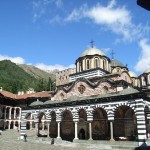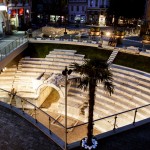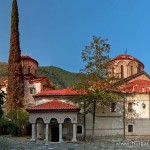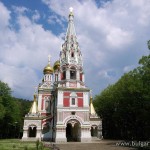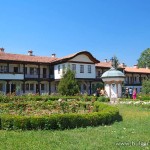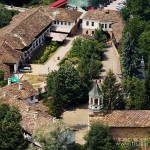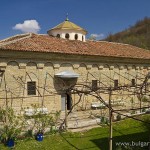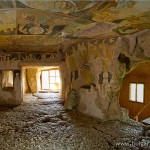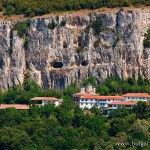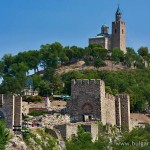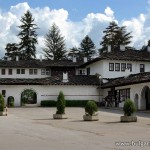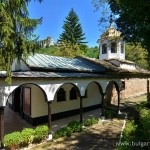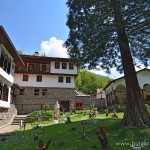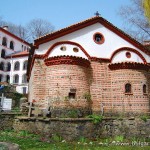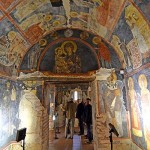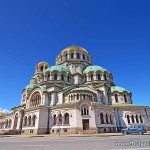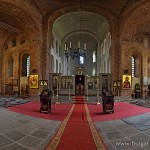Grand Monastery Tour
This tour presents all Bulgarian important Monasteries, which were built from 10th to 18th century, were used as schools and keep remains from Bulgarian history, handcrafts and culture.
Itinerary
Day-1
Arrival. Transfer to the city of Blagoevgrad. Overnight.
Day-2
Breakfast. Visit to the Rila Monastery, which is the biggest one in Bulgaria and is located in the Rila Mountains. Lunch. Transfer to Plovdiv. Two hours walking tour Old Plovdiv.
Rila Monastery is one of the symbols of Bulgaria and is also a popular tourist destination. Throughout the centuries Rila Monastery has always been the spiritual, educational and cultural center of Bulgaria. It is listed in UNESCO heritage sites.
Plovidv is considered to be one of the oldest cities in Europe. Here you will see some remains of a Thracian fortress (5th century BC) and well preserved
remains from the Roman times to our days.
The Old Town is a marvelous site, with its picturesque churches, the mosque and many houses with the architecture, the specific atmosphere and the spirit of Bulgarian Revival period.
Your guide will show you the fabulous remains of the Ancient Roman Empire – the Roman Stadium, the Roman Forum, the Amphitheater.
Day-3
Breakfast. Tour to Kuklen Monastery, Arapovski Monastery and Bachkovo Monastery, which is one of the biggest in Bulgaria. Lunch. Transfer to Shipka Monastery, which was founded in honor of the victims of the Russian – Turkish Liberation war. Overnight in Tryavna.
Bachkovo Monastery – the second largest monastery in Bulgaria, dates from the middle ages. The monastery was founded in 1083 by the Georgian Gregoriy Bakuriani, who donated the land. For a long time the monastery was Georgian.
Kuklen Monastery – Most valuable is the church wall-painting, parts of which can be seen from the outside on the west wall of the first vestibule and in three of the outer gabled bays of the building. Best preserved is the image of Archangel Michael in the southern bay.
Arapovo Monastery – The wall-paintings in the temple are extremely interesting, because they are the first to break away from the canon related to the way the lives of St. Cyril and St. Methodius are depicted: the two saints are portrayed as preachers and Baptists of the Bulgarian people.
Shipka Monastery – Here, on the sanctuary walls and in the outer galleries, there are 34 marble plaques listing the names of officers and volunteers, who died during the Russian-Turkish war of 1887-88. Some of these heroes died in the war’s most brutal battle on Shipka Pass not far from the town of Shipka. To the west of the church, there is a 53 meter high bell tower, containing a total of 17 bells, the largest of which weighs 1,643 kg.
Day-4
Breakfast. Sokolski Monastery, Dryanovo Monastery, Kilifarevo Monastery, Arbanasi village which has main role in the National Revival. Overnight in Veliko Tarnovo.
Sokolski Monastery of the Assumption is located in Sokolova Cave Area, 15 km southeast of Gabrovo and 4 km away from the Etar Architectural-Ethnographic Complex.
For centuries the Dryanovo Monastery “St. Archangel Michael” has been one of the centers of development of the Bulgarian Christianity and
culture, and nowadays it continues to attract worshipers and tourists. The museum exposition “Archeology and Revival” is placed in the Dryanovo Monastery. The relics, found in the area of the monastery are exhibited here, describing the development of the region.
Kilifarevo Monastery was founded in 1350 by Saint Teodosiy Tarnovski (Saint Theodosius of Tarnovo, a Bulgarian hermit monk canonized as a saint), under the patronage of Tsar Ivan Alexander (reign 1331-1371).
The village of Arbanasi is located on a high plateau 5 km from the city of Veliko Tarnovo.
It is known that the village existed during the time of the Second Bulgarian State (1185 – 1396). At that time, the Bolyari (nobles) living in the capital Tarnovo, used it as a summer residence. According to the legend, the Tsar of Tarnovo minted coins here.
Day-5
Breakfast. FD tour to Ivanovo Monastery, which is part of the UNESCO World heritage, Basarbovo Monastery, Patriarchal Monastery, Transfiguration Monastery. Overnight in Veliko Tarnovo.
The Ivanovo rock monastery “St. Archangel Michael” was founded in the year 1220 by the monk Yoakim, who later became a Bulgarian patriarch. The Bulgarian tsars Yoan Asen ІІ (1218-1241), Yoan Alexander (1331-1371) and other representatives of the royal court, were among the monastery donators, and their donor’s portrait are preserved to the present day.
Basarbovski Rock Monastery “St. Dimitrius Basarbovski” was 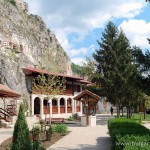 established during the existence of the Second Bulgarian Empire. The most famous inhabitant of the monastery was St. Dimitrius Besarbovski, who was born in 1685 in the village of Besarbovo, and spent his entire life in the holy monastery.
established during the existence of the Second Bulgarian Empire. The most famous inhabitant of the monastery was St. Dimitrius Besarbovski, who was born in 1685 in the village of Besarbovo, and spent his entire life in the holy monastery.
The Patriarchal Monastery of the Holy Trinity is located 6 km north of Veliko Tarnovo. It is situated in a beautiful area at the foot of an inaccessible rock. The monastery was the centre of Tarnovo Literature School during the time when Evtimiy was there. The monastery continued to flourish even after 1375 when Evtimiy was elected Patriarch.
Day-6
Breakfast. HD tour Veliko Tarnovo – the town of tsars, and Bulgarian Monasteries around the city. HD tour of Troyan Monastery. Overnight in Troyan.
Veliko Tarnovo is one of the oldest towns in the country, as its history dates back for more than five thousand years, which is proven by the archeological excavations.
The upsurge of Veliko Tarnovo is related to the period of the Second Bulgarian Empire (1185 – 1396). In 1185 the town was declared capital of the restored Bulgarian State by the brothers Asen and Petar, which marke the end of the Byzantine dominion, that continued for 167 years.
After its selection for a capital, the town developed fast, as within the period 12th – 14th century it was the most unconquerable Bulgarian fortress, as well as a cultural and intellectual center of Bulgaria and the Balkan peninsula.
Troyan Monastery, which is the third in size complex in Bulgaria, is a remarkable culture monument of national significance. According to the historical documents, the monastery was first founded in 1600 and reconstructed in the period 1830 – 1865 in its present look. As an architectural style of the buildings it is associated with the School of Revival.
Day-7
Breakfast. Visit of Cherepishki Monastery, Osenovlashki Monastery, Kremikovski Monstery. Overnight in Sofia.
The Cherepishki monastery “The Assumption of Virgin Mary” is located 29 kilometers southeast of the city of Vratsa, at the bank of the Iskar river.
The monastery was built during the reign of tsar Ivan Shishman (reigned 1371 – 1395). A legend says, that the name of the monastery (Bones Monastery) originates from the bones of those, who died in the battle between tsar Ivan Shishman and the Ottoman soldiers in the end of the 14th century.
The Osenovlashky monastery is also known as the monastery of the Seven Altars. It was founded in the 11th century and was a cultural and educational center over the centuries – books and manuscripts were re-written in it, and in the end of the 18th century Sofroniy of Vratza, a Bulgarian cleric and national Revival leader, resided there.
During the Ottoman Slavery the Kremikovtsi Monastery was an important literature and cultural center for Sofia’s residents and many liturgical books have been transcribed here. After the martyr’s death of St. Georgi Sofiiski (i.e. George of Sofia), some of his relics have been transferred in the monastery.
Day-8
Breakfast. Visit to Dragalevski Monastery, Boyana church which is part of the UNESCO world heritage, St. Alexander Nevski, the biggest Cathedral in Bulgaria and second largest on the Balkans, St. Nedelia, St. Sofia from where the name of the capital originates.
The Dragalevtsi monastery, named “Virgin Mary of Vitosha”, is located about 3 km kilometers south of the capital city. The monastery’s establishment dates back to the year 1345, the time of the Second Bulgarian State (which ended with the Ottoman invasion in Bulgarian lands at the end of the 14th century) and the reign of the Bulgarian King Ivan Alexander (1331-1371). In contrast to most other Bulgarian monasteries, Virgin Mary of Vitosha was saved from destruction by the Ottoman conquerors.
Boyana Church of St. Nicholas and St. Pantaleimon is situated at the foot of Vitosha Mountain and was included in the list of UNESCO World Heritage Sites in 1979. The eastern part of the church is a small single-apsed, cross-in-square building with built-in supports that form a cross. The first layer of wall-paintings that covered the entire eastern part of the temple dates as far back as the 12th century. The second two-storey part of the church that belongs to the two-floor tomb-church type was built in the 13th century thanks to a donation made by Sebastocrator Kaloyan and his wife Desislava, who ruled the Sofia (Sredets) Region during that period.
The cathedral temple “St. Alexander Nevski” is considered a symbol of the Bulgarian capital. It is
located in the center of Sofia, at the eponymous square. The reflection of its golden domes attracts attention from miles away.
The temple was built in honor of the Russian Emperor Alexander the 2nd, also known as the Tsar – Liberator, whose army liberated Bulgaria of the five-century long Ottoman Dominion in 1878.
The church “St. Sofia” (God’s Wisdom) is situated in the center of Bulgaria’s capital, in close proximity to the Monumental Temple “Alexander Nevski”. It is one of the oldest churches in Sofia and it’s history is closely related to the capital’s history. Nowadays the temple is considered to be one of the symbols of Sofia.
Day-9
Breakfast. Transfer to the hotel.
Additional Days
You may add more days to your tour at special price for accommodation to explore Sofia by yourself or to join Zelanos one-day tours.
Prices: Upon request
-
Person in DBL / TRPL
-
Person in SNGL
-
Child 2 – 11.99 y.o.
-
Infant 0 – 1.99 y.o. – FREE
Supplements – optional:
-
Lunch
-
Dinner
-
Accommodation in 4* and 5* hotels supplement per person
Additional nights in Sofia, per person, per night:
-
Hotels 3*
-
Hotels 4* / 5*
Notes:
Please, send request for rates
Optional excursions:
-
Wine tasting in Lyaskovets
-
Folklore Dinner in Plovdiv
-
Folklore Dinner in Sofia

